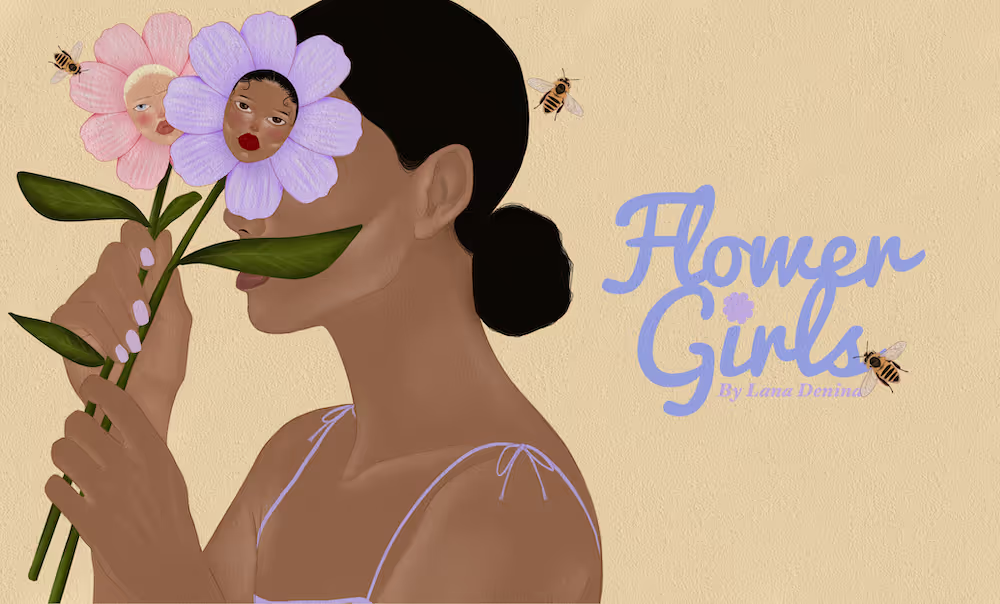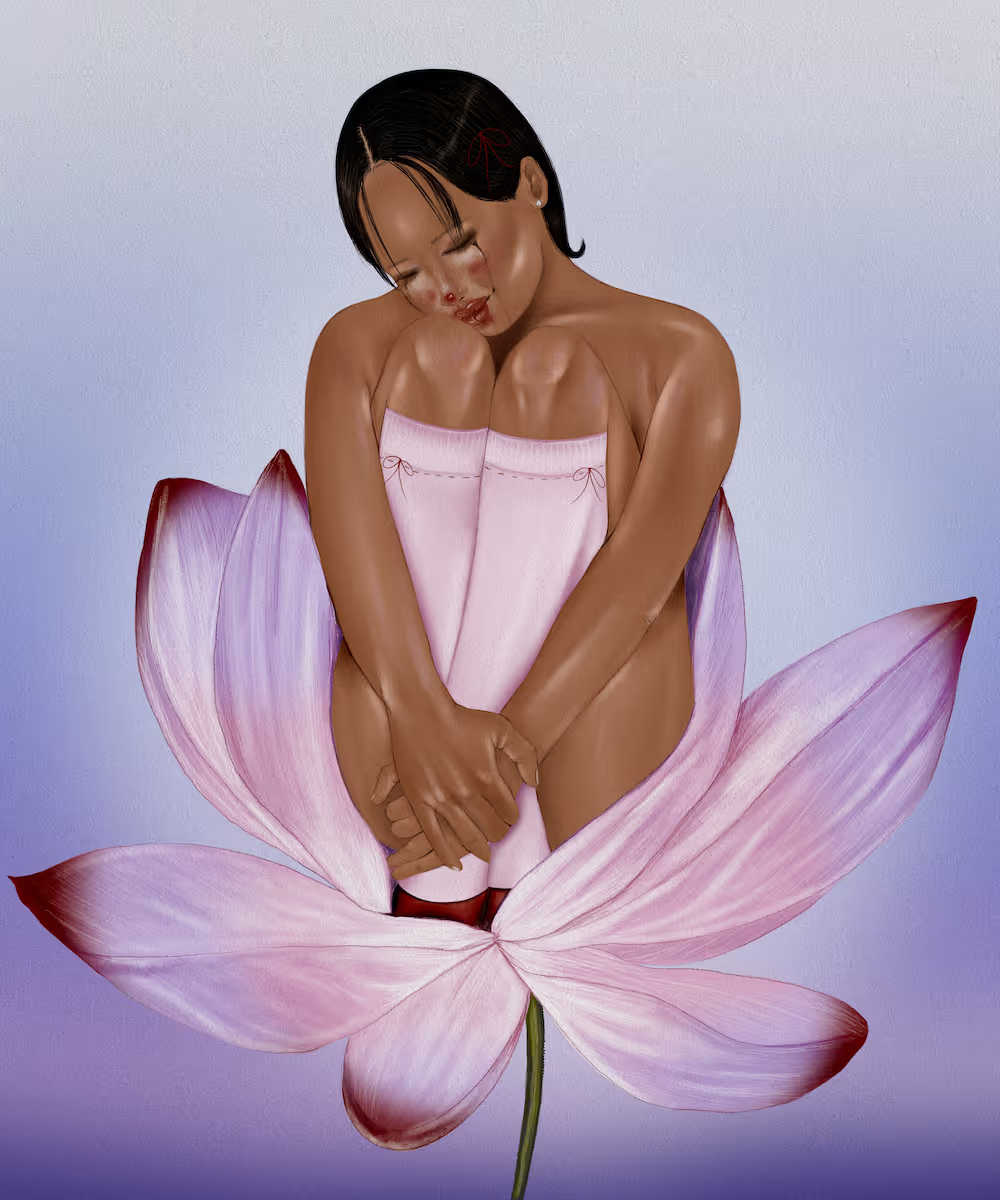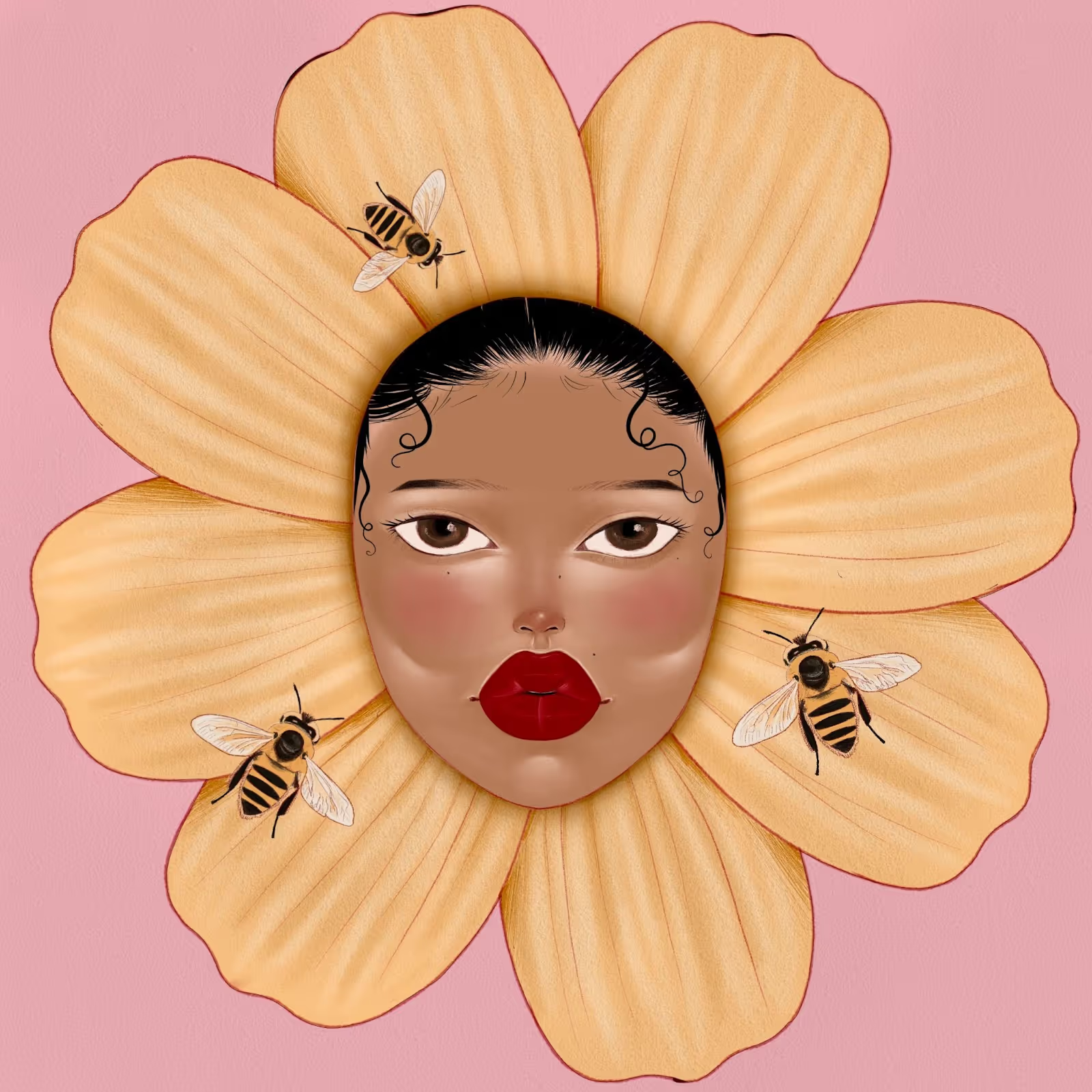Lana Denina’s work is a celebration of cultural fusion, vibrant storytelling, and the transformative power of art. Born in Benin, spending early years in France, and now based in Montreal, Lana’s multicultural heritage deeply shapes her artistic voice. Her surrealist style marked by vivid colors, striking female characters, and a blend of global influences explores identity, womanhood, and emotional resilience.
This week, Lana brings her latest project, Flower Girls, to OpenSea. Inspired by her travels, personal growth, and lifelong love of flowers, the collection radiates joy, transformation, and connection. From racially ambiguous portraits blooming within petals to a physical coaster set that ties the work to everyday life, Flower Girls is a vibrant invitation to share positivity.
We spoke with Lana about her journey from marketing to web3, the evolution of her artistic style, and the story behind Flower Girls.
Note: This interview has been edited for length and clarity.

OpenSea: I’d love to start from the beginning of your journey because I know you were originally born in Benin, and then were you raised between France and Canada?
Lana Denina: I was born in Benin, and then we moved to the south of France. I grew up in the south of France until I was 10 years old, and then we moved to Montreal, Canada. I grew up Canadian more than anything, but with all of my multicultural heritage. It shaped me completely.
OpenSea: How have your multicultural roots shaped your artistic voice?
Lana Denina: At first, I was painting—well, drawing—when I was really young with my sister. She draws really well; she’s really good. I got the will to draw from her because she was my idol—she’s my big sister, you know.
Then it became my hyperfocus to make art and paint. My mom was a fashion stylist, and my dad is a really good painter as well. So, we always had a lot of art in the house. We also love to travel. My dad is Jewish, from Algeria, but he grew up in France, so he’s French as well.
My mom is from Benin. They’re two really opposite cultures, but they merge together so well. I’ve always tried to incorporate that mixture of cultures in my art. I wanted the people I drew to be racially ambiguous—you don’t really know where they’re from—so everyone can identify with them.

OpenSea: That’s amazing. Your academic background is in marketing—how did you transition from that into being an artist in web3?
Lana Denina: When I came across web3, I was still doing marketing. It was during COVID. I had previously spent one year not doing marketing—just focusing on my art—and then I went back to my studies. But I felt like I wasn’t doing something that made me happy. Whenever I created art, I felt really happy. I felt like I was breathing, like I’d achieved something. That’s when I decided I wanted to make art full-time. I didn’t want to do anything else. I really wanted to focus on creating a career out of my art.
Marketing was great because it taught me how to market myself, which is really important for an artist. It gave me tools, and I’m grateful for that. But now I’m going to study fine art.
OpenSea: Oh, cool! That’ll be such an amazing experience. Your work is mainly a surrealist style, with vibrant colors featuring female characters. What were the biggest influences in developing your signature style?
Lana Denina: It was a hard process to find my voice. I think it’s hard for any artist to find their true style. What I focused on was following what I drew effortlessly. That’s how I knew—that’s my style. They always have a particular face, a particular way of posing.
I like them to look like editorials, like models. But not too much. I like the doll effect. I like them to look picture-perfect, but I like the paintings to talk about meaningful subjects. I like to talk about mental health and things like that. My style is always about women—mainly about the journey of womanhood, how society wants us to look perfect, and how that impacts our mental health. We don’t always show the true struggles of womanhood. There’s this facade of looking perfect, but not really showcasing the true colors.
That’s how I shaped my style. Artistically, it’s a mix of artists from all around the world—a lot of African artists, Asian artists, South Asian, French—so many. It’s a mix, and then I found my own style.

OpenSea: It makes sense that you’re taking techniques from all over the world. For the “Flower Girls" collection that’s dropping on OpenSea, can you tell us about the concept behind it?
Lana Denina: Yes! Flower Girls is a project I’m really happy to drop. I sketched it last year, so it was a long time ago. I was in Mexico and wanted to make happy art—not too complicated, something anyone could enjoy instantly. I have this habit of sketching faces on little sticker cards.
I wanted them to be in flowers because I did a piece before—a girl comforting herself inside a flower. It’s called I Was a Clown for Ever Loving You. It was after a breakup. She felt foolish for loving someone who betrayed her, and she sought comfort inside the flower—she’s holding herself inside it. I always find comfort in looking at flowers. I have a big garden, and my mom always plants many flowers there. She tells me the stories—“If you want this flower to grow beautifully, you have to talk to her,” and things like that.
I’ve always been a lover of flowers, so I thought, “Let me merge the faces I draw with flowers.”
They became the Flower Girls, and I thought, “That’s so cute.” I made coasters out of it because I love hosting as well. People love when I make merch for the house—I’ve made towels, throws, blankets. So I thought, why not something for the table? I made the sample last year and didn’t touch the project for a while because I wanted to be sure how I would bring it to life. Then I got the idea of making it into a big collection. I love big collections because I love when many people can own my art—not just one collector.
I love when there’s a big community of people. I wanted to spread positivity with the flowers.
OpenSea: I love that! I was going to ask about the coasters and how you decided on them, because I saw on the drop page that if you collect four “Flower Girls,” you can claim a coaster set.
Lana Denina: I think it’s always special to have a physical item tied to digital art. Coasters felt like the perfect choice — they’re functional, beautiful, and make a great universal gift. I love the idea of art becoming part of your everyday life, something you can actually use and share. That’s why I designed them in the shape of a flower, to keep the spirit of the collection alive in a tangible way.
OpenSea: That’s really cute. Also, with “Flower Girls”, there’s the idea of flowers growing and transforming. Is that what the series represents—like how you said your other artwork dealt with a breakup, and now this is transformation?
Lana Denina: Yes. It’s about flourishing and making beauty out of sadness—appreciating the feeling of blossoming into something stronger. It’s a really meaningful project for me.
That’s why I wanted to make it such a large collection. To multiply the positivity.

OpenSea: You drew the collection when you were in Mexico—what was the rest of the process like for creating the styles, colors, or traits? I saw some had water droplets, and others had bees. I loved those details.
Lana Denina: For the petals, they’re all real colors of real flowers—25 different flowers, 25 different colors. Some have more details, like bees or water droplets. They’re more rare, but they’re just little accessories to make the flowers more alive—the bees, the water, the butterflies. Those are the additions.
I really want people to have fun with the Flower Girls. I want them to be gifts to share with others because there are a lot, and I want them to send them to friends. I want to spread positivity with this project. I want it to be a happy, cheerful project.
OpenSea: Beyond “Flower Girls”, is there anything coming up for you in 2025? Any projects, exhibitions?
Lana Denina: Yes, I have more paintings coming—real-life exhibitions, too. I can’t share too much, yet.
OpenSea: Got it. I’ll keep an eye out for them since I know you can’t reveal too much. How do you envision your art evolving? Your work mainly explores identity, community, and technology. How do you see that evolving?
Lana Denina: That’s a good question. I see it evolving with me because it’s really a reflection of myself, my stories, my friends, the women I know. The wiser I get, the wiser my art gets. I see it evolving into maybe more mature, stronger work.
OpenSea: Before we wrap up, is there anything else you would like to add?
Lana Denina: Yes! I’d like to give a big thank you to Itàn World, an African art collective that has been helping me with the promotion and storytelling of this collection.
OpenSea: Thank you for chatting with us! I love your art and I’m really excited for the mint.
Lana Denina: Thank you!
.avif)




.avif)
.png)
.png)
.png)




.png)